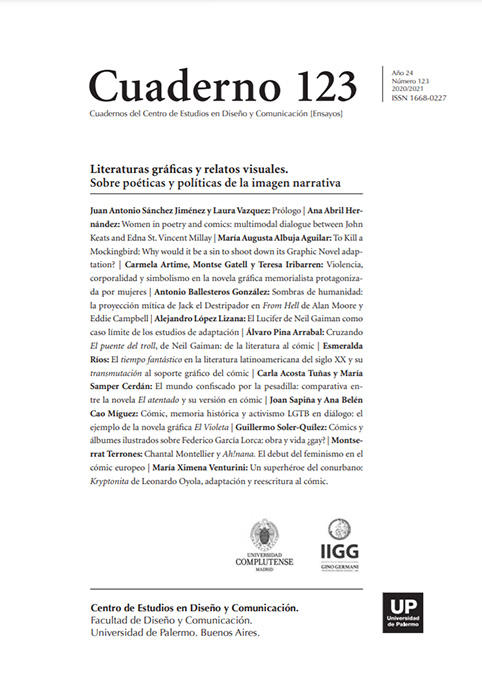Women in poetry and comics: multimodal dialogue between John Keats and Edna St. Vincent Millay
Resumen
El formato del cómic ha tenido un visible aumento en el número de lectores que han elegido este medio para profundizar en los procesos de creación de significado en textos multimodales. No obstante, poco se ha dicho hasta ahora acerca de la adaptación de ciertos géneros literarios a la forma del cómic. Este es el caso de la poesía, la poesía narrativa, en particular, ilustrada en este estudio en la célebre balada “La belle dame sans merci” (1819) de John Keats y el soneto moderno “The singing-woman from the wood’s edge” (1920) de la poetisa feminista estadounidense Edna St. Vincent Millay. A raíz de dos adaptaciones recientes al formato cómic de estos poemas, la presente investigación explora desde un enfoque comparatista los procesos semióticos que están en juego a la hora de representar a las mujeres en ambas obras desde el punto de vista de sus respectivos poetas. Esta investigación también estudia la visión de las mujeres desde el punto de vista de los artistas gráficos correspondientes para examinar los cambios en la representación de la mujer en la poesía desde la imagen romántica, hasta la visión de la mujer desde principios del siglo XX, hasta nuestros días.
Citas
Abril Hernández, A. (2019). Revisiting Edna St. Vincent Millay: the forgotten authoress who marked a generation. In I. Mukherjee and J. Singh (Eds.), Gendered ways of transnational un-belonging from a comparative literature perspective. Newcastle upon Tyne: Cambridge Scholars Publishing, 176-189.
Alwes, K. (1993). Imagination transformed: the evolution of the female character in Keats’s poetry. Edwardsville: Southern Illinois University Press.
Baetens, J. (2011). “Abstraction in comics,” SubStance, Vol. 40, Nº 1, Issue 124, 94-113.Doi:10.1353/sub.2011.0004.
Bates, B. (2016). Graphic and digital Keats: ‘La belle dame sans merci’ in poetry comics. Reconstruction: studies in contemporary culture, Vol. 16, Nº 1, n/p.
Bennett, T. (2014). “Comics poetry: the art of the possible,” Cordite poetry review. November 1. http://cordite.org.au/scholarly/comics-poetry/.
Bolter, J. D. and Grusin, R. (1999). Remediation: understanding new media. Cambridge: MIT Press.
Cotsell, M. (2005). The theater of trauma: American modernist drama and the psychological struggle for the American mind, 1900-1936. New York: Peter Lang.
DuPlessis, R. B. (2012). Social texts and poetic texts: poetry and cultural studies. In C. Nelson (Ed.), Oxford handbook of modern and contemporary American poetry. Oxford: Oxford University Press, 53-70.
Earle, H. (2017). Comics, trauma, and the new art of war. Jackson: University Press of Mississippi.
Eisner, W. (1985). Comics and sequential art. Florida: Poorhouse Press.
Fried, D. (1986). “Andromeda unbound: gender and genre in Millay’s sonnets,” Twentieth century literature, Vol. 32, Nº 1, 1-22.
Gilbert, S. M. and Gubar, S. (1994). No man’s land: the place of the woman writer in the twentieth century, volume 3. Letters from the front. New Haven: Yale University Press.
Hutcheon, L. (2013[2012]). A theory of adaptation. 2nd Edition. London: Routledge.
Keats, J. (2001). Complete poems and selected letters of John Keats. Modern Library Paperback edition. New York: The Modern Library.
Kelley, T. M. (2007). Poetic and the politics of reception: Keats’ ‘La belle dame sans merci.’ In H. Bloom (Ed.), John Keats, Updated edition. New York: Chelsea House Publishers, 67-96.
Kolitsky, J. (2013). The singing-woman from the wood’s edge. In R. Kick (Ed.), The graphic canon vol. 3: from Heart of Darkness to Hemingway to Infinite Jest. Hong Kong: Seven Stories Press, 188-195.
Kress, G. R. and van Leeuwen, T. (1996). Reading images: the grammar of Visual design. London: Routledge.
Kress, G. (2005). Before writing: rethinking the paths to literacy. London: Routledge. McCloud, S. (1994). Understanding comics: the invisible art. New York: HarperCollins Publishers.
Millay, E. St. V. (2000). First fig and other poems. (J. T. Pine, Ed.). New York: Dover Publications Inc.
Millay, E. St. V. (2016[1941]). Selected poems of Edna St. Vincent Millay. New Haven: Yale University Press.
Montefiore, J. (1987). Feminism and poetry: language, experience, identity, in women’s writing. London: Pandora. Newfield, D. (2013[2009]). “Transformation, transduction and the transmodal moment.” In C. Jewitt (Ed.), The Routledge handbook of multimodal analysis. London: Routledge,
-114. Peters, J. (n/d). “La belle dame sans merci’ by John Keats.” Julian Peters Comics. Retrieved from: https://julianpeterscomics.com/la-belle-dame-sans-merci-by-john-keats/ (Accessed: 20/11/2019).
Twitchell, J. (1975). La belle dame as vampire. CEA Critic, Vol. 37, Nº 4, 31-33. Retrieved: 5/12/2019, from www.jstor.org/stable/44376836.
Weldon, G. (2016). The term ‘graphic novel’ has had a good run. We don’t need it anymore. November 17, 2016. Retrieved from: http://www.npr.org/sections/monkeysee/2016/11/17/502422829/the-term-graphic-novel-hashad-a-good-run-we-dont-needit-anymore (Accessed: 03/12/2019).
Wyatt-Smith, C. and Kimber, K. (2009). Working multimodally: challenges for assessment. English teaching practice and critique, Vol. 8, Nº 3, 70-90.
Los autores/as que publiquen en esta revista ceden los derechos de autor y de publicación a "Cuadernos del Centro de Estudios de Diseño y Comunicación", Aceptando el registro de su trabajo bajo una licencia de atribución de Creative Commons, que permite a terceros utilizar lo publicado siempre que de el crédito pertinente a los autores y a esta revista.


